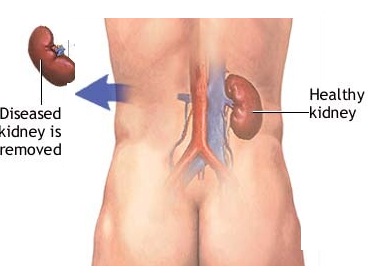LAPAROSCOPIC KIDNEY REMOVAL

DESCRIPTION
This surgery is done in the hospital while you are asleep and pain-free (general anesthesia). The procedure can take 3 or more hours.
Simple nephrectomy or open kidney removal:
You will be lying on your side. Your surgeon will make an incision (cut) up to 12 inches or 30 centimeters (cm) long. This cut will be on your side, just below the ribs or right over the lowest ribs.
Muscle, fat, and tissue are cut and moved. Your surgeon may need to remove a rib to do the procedure.
The tube that carries urine from the kidney to the bladder (ureter) and blood vessels are cut away from the kidney. The kidney is then removed.
Sometimes, just a part of the kidney may be removed (partial nephrectomy).
The cut is then closed with stitches or staples.
RADICAL NEPHRECTOMY OR OPEN KIDNEY REMOVAL:
- Your surgeon will make a cut about 8 to 12 inches (20 to 30 cm) long. This cut will be on the front of your belly, just below your ribs. It may also be done through your side.
- Muscle, fat, and tissue are cut and moved. The tube that carries urine from the kidney to the bladder (ureter) and blood vessels are cut away from the kidney. The kidney is then removed.
- Your surgeon will also take out the surrounding fat, and sometimes the adrenal gland and some lymph nodes.
- The cut is then closed with stitches or staples.
LAPAROSCOPIC KIDNEY REMOVAL:
- Your surgeon will make 3 or 4 small cuts, most often no more than 1 inch (2.5 cm) each, in your belly and side. The surgeon will use tiny probes and a camera to do the surgery.
- Towards the end of the procedure, your surgeon will make one of the cuts larger (about 4 inches or 10 cm) to take out the kidney.
- The surgeon will cut the ureter, place a bag around the kidney, and pull it through the larger cut.
- This surgery may take longer than an open kidney removal. However, most people recover faster and feel less pain after this type of surgery when compared to the pain and recovery period following open surgery.
